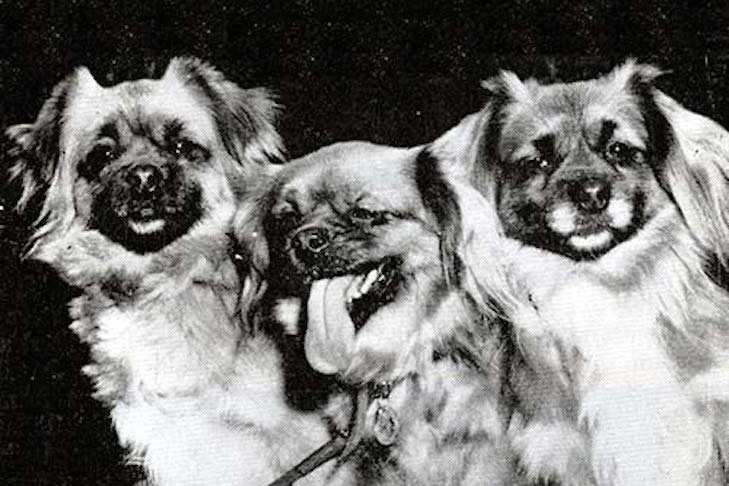
If you are reincarnated as a dog, make sure you come back as a Tibetan Spaniel.
The region with the highest altitudes on our planet – hence its nickname, “the Roof of the World” – Tibet was forever changed when Buddhism arrived from northern India in the 7th and 8th centuries. Sprawling white monasteries began to rise from its rugged mountainsides, with hundreds of windows to invite in the warming sunlight and flat roofs to capture that heat and encourage it to linger. Like their European corollaries, Tibetan monasteries became centers of art and learning, with families sending their young sons to don the saffron-dyed monk’s robes in the hopes of acquiring an education – and a future.
Despite its inhospitable climate – or perhaps because of it – Tibet is home to a half-dozen dog breeds, to say nothing of the mixed feral dogs that hung around the monasteries, where they were fed and looked after by the karma-conscious monks within. The largest of these native breeds was the Tibetan Mastiff, which would guard the monastery entrance and ferociously deter intruders as it strained against the chains that contained it.
But the dog that had the most intimate access to the monasteries – and the learned monks and lamas who lived within them – was the Tibetan Spaniel.

Are Tibbies Even Spaniels?
“Tibbies,” as they are affectionately nicknamed, are in fact not spaniels at all: Historically, that term refers to smaller-sized European-derived bird dogs with long, wavy hair and feathered ears and tails. But as many of the most diminutive spaniels abandoned the field for the comfort of the couch, the term began to be used more generically to refer to lapdogs, no matter what their derivation.
By all accounts, Tibetan Spaniels certainly fit that description. Referred to as “Simkyi” – which means “house dog,” or even “bedroom dog” – these were treasured companions, accompanying the monks on their meditative walks and warming their beds at night. Though the legend that Tibetan Spaniels were used to turn Tibetan prayer wheels is likely just that – a legend – it nonetheless communicates how highly regarded the dogs were, and how intimately they were associated with spiritual life in these mountainside fortresses.
Indeed, because Buddhist belief holds that humans – even lamas themselves – could be reincarnated as dogs in order to fulfill their karmic destiny, dogs were looked on as more than merely companions. In the Tibetan Spaniel, which sat so calmly on their laps during meditation, and was so intelligent and intuitive, the monks found a highly evolved soul that was, for all intents and purposes, a kindred spirit.
Being beautiful to look at and pleasant to stroke were high on the list of the Tibetan Spaniel’s duties. Like all the dog breeds that evolved in the harsh Tibetan climate, it has a long, protective outercoat, and a soft, warm undercoat. As with the short-faced Pekingese in nearby China, the Tibetan Spaniel was bred for centuries by the monks to resemble a little lion, as that king of beasts is a sacred Buddhist symbol. While all coat colors are considered acceptable according to the modern Tibetan Spaniel standard, cream and gold dogs were appreciated for their resemblance to lions. Black-and-tan-patterned dogs were favored, as were black dogs with a white spot on the chest, which was said to signify a pure heart. (A white tail tip, however, was not desirable, as it was a sign that a previous lifetime had involved stealing tsampa, the Tibetan food staple made of roasted barley flour.)

Lapdogs and Watchdogs
Not content to lie on soft, inviting pillows all day, the Tibetan Spaniels also served as very competent watchdogs. Alert and intelligent, with keen eyesight and hearing, they would perch on the tall monastery walls, barking at anything out of the ordinary. The only threat to the long-lived Tibetan Spaniel was the apex predator of the Tibetan plateau, the snow leopard. These cunning cats would sometimes snatch the defenseless dogs from the monasteries’ rooftops.
As with most breeds that were cultivated in such exclusive environs, Tibetan Spaniels could not be bought at any price. Instead, they were gifted to those considered worthy of their ownership. Invariably, these engaging little dogs were sent to the royal palaces of China and other neighboring Buddhist countries, and as a result of this diaspora very likely contributed to the formation of other well-known Asian breeds, such as the Pekingese.
In 1898, the first Tibetan Spaniels arrived in England, which is where they acquired their misguided spaniel moniker. By then, the Victorians had already become besotted with other flat-faced breeds from the Far East, in particular the Pug and Pekingese, and the more moderately constructed Tibetan Spaniel flew under the radar. By the end of the second world war, only one Tibetan Spaniel had survived in all of England. But thanks to the single-minded devotion of a handful of fanciers, new breeding stock was imported and the breed’s numbers began to increase.
The timing could not have been more fortuitous. With the onset of the Cold War in the 1950s, the Bamboo Curtain fell. Tibet was annexed by China, many of its monasteries destroyed, and its monks and nuns imprisoned. While some monasteries survived – and with them some of these irrepressible lapdogs – the West became the breed’s safe harbor.
Today, Tibetan Spaniels are more likely to be found perched on a windowsill in suburbia than on the wall of a monastery on the plateau. Still, their devotion, intelligence, and watchfulness persist, leaving admiring owners to contemplate their own good karma in acquiring such a captivating companion.

